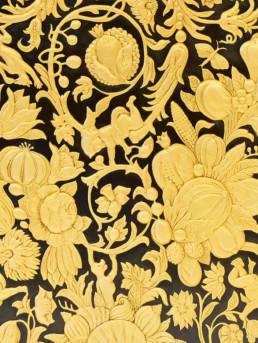What is gilded leather?
Gilded leather that originated in the 6th century is leather with a golden layer. This golden layer is obtained by applying the leather with silver leaf, and then providing a yellow varnish. Gilded leather, therefore, is not golden leather, as the name indicates.
On stretched leather sheets, a layer of silver leaf is applied. In order to prevent the silver from oxidizing, two coats of varnish are applied, which give it the final golden colour. After varnishing, the other colours are applied.
Another process is to apply relief to the gilded leather. This so-called ‘elevated’ leather was initially characteristic of the northern Netherlands. With a mould, the gilded leather is printed in relief, after which it is then painted, quite often by hand…
Based on industry standards, only water-based paints and varnishes are used. The vegetable-tanned leather that is used creates a traditional, honest and eco-friendly product.

Gilded leather in the middle ages
Around the Middle Ages, gilded leather was made in Spain. The Spaniards named the gilded leather ‘Guadamaciles’. This ‘Guadamaciles’ was fabricated in various cities, including the city of Cordoba where, in the 9th century, the manufacturing of gilded leather would already have existed. Cordoba was considered to be an example for many other manufacturing sites, which then were established in the north of Spain. Cities famous for this are Madrid, Valladolid and Ciudad. Gilded leather was also produced in Lisbon, Portugal.
Production and quality of the gilded leather were controlled by the guilds. From the 14th up to and including the 17th century, the gilded leather was exported to various European regions.
Gilded leather in the 17th century
From the 17th century, the other parts of Europe also started producing gilded leather. For Spain this meant a heavy blow to the gilded leather industry. The new gilded leather companies established themselves especially in Italy, with Venice as its main city. Here, the gilded leather technique was slightly modified, by using less relief after processing. This gilded leather also found its way into France and Flanders where, since 1511, all gilded leather was produced. Around the same time, gilded leather was also produced in England, the Netherlands and Germany. The first gilded leather maker was established in 1612, in the Northern Netherlands.
Gilded leather in the 18th century
Until 1797, Mechelen (Belgium) had been a very important production centre for gilded leather. Cities in the north of the Netherlands, especially Amsterdam and The Hague, were important gilded leather production centres. In the Netherlands, both in the 17th as well as in the 18th century, gilded leather was enormously popular as a wall covering.
Gilded leather in the Netherlands
The gilded leather in the Netherlands is known for its strong relief. In Spain and France, one especially made use of sheep and goat leather; in the Netherlands, however, the beautiful, smooth calfskin leather was especially used. Gilded leather was used as a wall covering, but was also applied to chairs, furniture and suitcases. Gilded leather can be found in palaces, castles and public buildings.